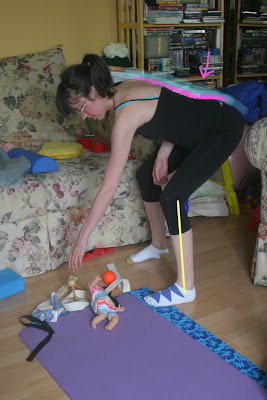 | |
| First image: hips forward, loading the feet. Second image, knees bent, loading the knees and the feet. Third image, hips over heels, loading the posterior muscles. |
A nice, flexible foot will be able to form to the surface you are walking on, giving you greater stability. If your foot can't move to accommodate a rock or a hole in the ground, or a rogue Lego, some other joint will have to (sprained ankle, knee), or you fall over and break a hip.
 |
| The side of my foot can come up over the block so I don't have to fling my whole body to the floor to avoid getting hurt. If I carried my weight in my toes, this would be very painful. |
When you carry your weight on your toes, your foot has to contract and grip the ground all the time to hold you up. This puts a significant amount of strain on the small muscles and soft tissues of your feet, makes the muscle stiff and unyielding, and actually cuts off blood flow to your foot. Your poor foot loses its fantastic range of motion and will be in pain and may even start to deform from the strain (bunions, hammer toes, flat feet, etc.)
The size of muscles and bones can give us a clue to their intended function. Bigger muscles and bones should be doing heavy load bearing work. Smaller muscle and bone is more for proprioception and other functions, like the delicate task of capturing nose goblins from a sleeping 2 year old. When you carry your weight back in your heels and turn OFF your quads, you allow the large muscles on the back of your leg and your butt to hold your weight, rather than the teeny tiny bits and pieces that make up your feet.
Another thing to look at is the effect of a contracted muscle on other parts of your body. When you use the back of your legs and your butt to hold you up, your butt muscles gently tug your tailbone outward, which maintains a healthy tone to your pelvic floor ( it is attached to your tailbone). Cool! When you use your quads to hold you up, either by having your hips shoved forward or having your knees bent, it pulls your kneecap up and into the knee joint, grinding through the cartilage, creating lots of friction and inflammation, leading to chronic pain/disease, eventually knee replacement. Uh-oh. Also, you lose any toning effect on the pelvic floor. Dang.
The last thing I'll mention is the effect that the placement of your weight has on your bones. In order for your hip bones (femoral heads) to develop and maintain their proper density, your legs MUST be vertical. Your leg bone is triggered to grow (ie, NOT degenerate over time) through the compression it gets between the ground and gravity.
A tilted leg bone, as in hips forward OR knees bent, is not getting the right amount of compression, which means your bones are not as strong as they have to be for your weight. If I weigh 100 lbs, I want my bones to be able to handle that weight when I'm walking, or if I have to jump to avoid getting hit by a bus, or if I'm going downstairs and I think there's another step but there's not and I land hard on my leg and get that jolt that reverberates through my skull (we've all done it) . If I don't bear my weight on my bones properly, that means that maybe they'll only be able to handle 85% of my weight, which is bad news for me in the above scenarios. I don't know about you, but I'd REALLY rather have my bones strong enough to hold me up, since I have an aversion to chronic pain and osteoporosis and hip fracture.
(A side note, this is why time spent sitting is such a big factor in the development of osteoporosis. Those hours you spend sitting in a chair are hours that you're telling your bones to go on vacation. A horizontal bone isn't getting ANY compression from gravity, so it isn't getting ANY signal to replenish!)
So there's my case for standing with your weight in your heels, and for learning how to relax your quads when you stand around. Makes sense, doesn't it?


















